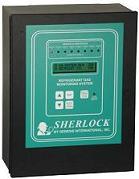|
SHERLOCK 402 Refrigerant Gas Monitoring System |
|
|
Monitoring Panel The Sherlock 402 Control Module is a hard wired, electronic control panel that is capable of monitoring the analog output signal of up to eight Sherlock Refrigerant Gas Sensors or seven Sherlock Refrigerant Gas Sensors and one Sherlock Oxygen Depletion Sensors and two digital dry-contact switches. The Control Module will activate four Form C SPDT relay contacts based upon the programmed alarm setpoints of each sensor. The relays are referred to as K1A, K1B for the first alarm level and K2A, K2B for the second alarm level. There is optional zone isolation alarm relay (A-H) for each Sensor. The Control Module can be located in the area to be monitored, or in a separate location, typically outside of the monitored room. Monitoring Points Each monitoring point consists of an analog signal generating sensor connected to the control module via discrete, three conductor cable. Each sensor can be mounted up to 800 feet (longer run with special cable) away in locations where leaked refrigerant is likely to concentrate. The gas sensors are available in three varieties: Ceramic Metal Oxide Semiconductor (CMOS) or Solid State Sensor Non-Dispursive, Pyro-Electric Infrared Sensor. Oxygen Depletion Electro-chemical Sensor. Alarm Level Settings The Sherlock 402 allows you to set a unique Level 1 Alarm Setpoint and Level 2 Alarm Setpoint for each individual sensor. When an Alarm Setpoint is exceeded, corresponding alarm relays are activated Each Alarm Setpoint has a programmable Alarm Delay, 1 to 120 minutes. Sensor readings are required to exceed an Alarm Setpoint for the programmed amount of time before the control activates the corresponding alarm relay contacts. For example, if the Alarm Setpoint is 200 and the Alarm Delay is five minutes, the control will enter an alarm condition only if the sensor detects a level of 200 or higher for more than five minutes. Alarm Indication All alarms are logged to indicate which sensor went in and out of any of the two alarm levels, the time and date of the alarm. The alarm log stores the last 32 alarms. When a sensor is in alarm, an alarm LED for this sensor on the front panel will turn to red color, the on-board beeper will be beeping and the display will show the activated alarm level. Alarm Relay Contacts The Sherlock 402 provides two fused SPDT (Single Pole Double Throw) relay outputs for each alarm level that switch positions in the event of an alarm condition. Level 1 Alarm activates K1A and K1B relays. Level 2 Alarm activates K2A and K2B relays. Level 2 alarm on each individual sensor can be disabled. One alarm relay on each level (K1B/K2B) can be silenced (returned to non-alarm state) when the SILENT button on the front panel is pushed. The other alarm relay will remain active until the alarm condition is cleared. The Sherlock 402 can be programmed so that the alarm is cleared automatically when the air is cleared below the alarm setpoint (UNLATCHED) The relays can also be programmed so the alarm is latched "ON" until the alarm is manually reset. The K1/K2 alarm level can be configured so the relays are "Energized to Alarm" (where the C-NC contacts open on alarm) or "De-Energized to Alarm" (where the relay is energized during normal operations and the C-NC contacts close on alarm). Optional zone isolation alarm relay(A-H) for each sensor can be programmed to activate by level 1 or level 1&2 alarm. Sensor Failure Monitoring The Sherlock 402 constantly monitors the wiring to the sensors. Should any of the activated sensor wires be cut or disconnected, "OPEN" will appear on the SHERLOCK display, the K1A and K1B relays will be activated and the condition is logged. Setback Alarm Settings In some locations the sensor may be expected to function in two different environments. For example, the sensor may have to perform in still air (i.e. with the exhaust fan off) and in moving air ( i.e. with the exhaust fan on), or the sensor may be used in a location where changes in air quality, perhaps caused by the use of propane powered floor buffers, elevates the sensor readings. The Sherlock 402 provides a feature called SETBACK to accommodate alternate environments under which the sensor would operate. SETBACK provides a second ALARM SETPOINT and a second ALARM DELAY enabling the sensor to perform in this second environment. The Sherlock 402 switches to the second set of parameters when a dry contact (i.e. air flow, sail switch or timer) closes or on a daily time schedule. Each sensor can be programmed with one of five SETBACK options: 1) No SETBACK 2) SETBACK triggered by setback input 1 and the Setback Clock 3) SETBACK triggered by setback input 2 only Each sensor can be programmed with only one SETBACK option; however, different sensors may be programmed to follow different options. |
|
